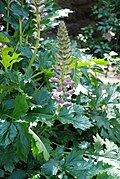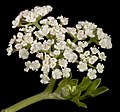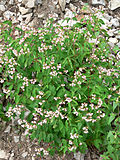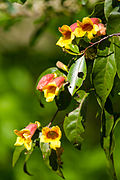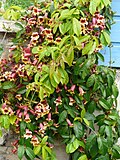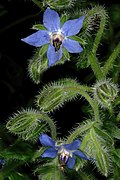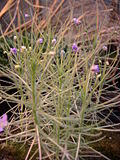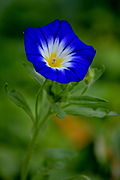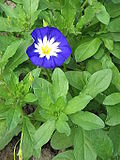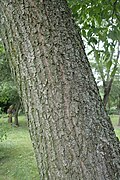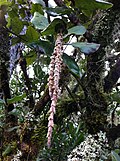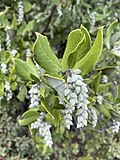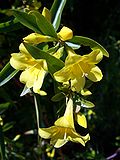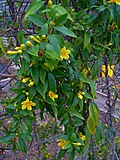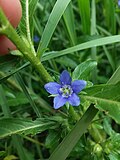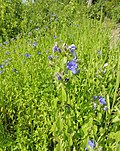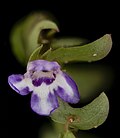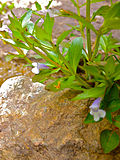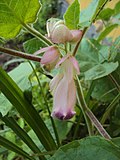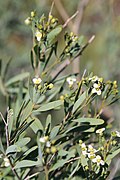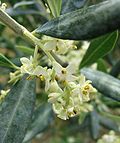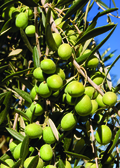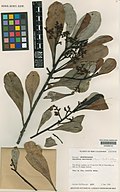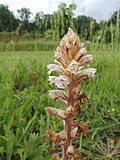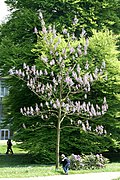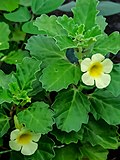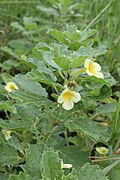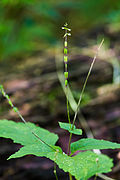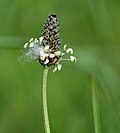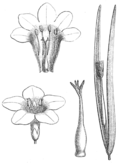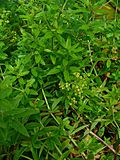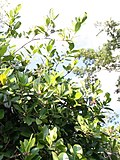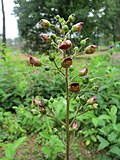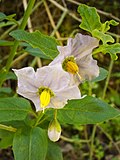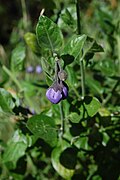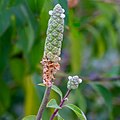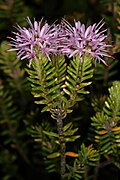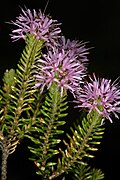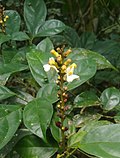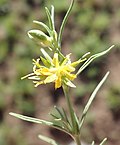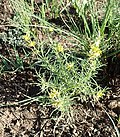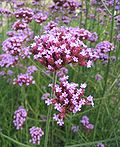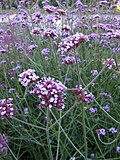Top Qs
Timeline
Chat
Perspective
List of euasterid families
From Wikipedia, the free encyclopedia
Remove ads
The euasterids or core asterids are a group of 69 interrelated families in 15 orders of flowering plants.[3][4][a] They tend to have petals that are fused with each other and with the bases of the stamens, and just one integument (covering) around the embryo sac.[3] The asterids as a whole (the euasterids plus two orders of basal asterids) represent almost a third of all flowering plant species.[8]

The euasterids include trees, shrubs, vines and herbaceous perennials and annuals. Sweet potatoes are a tropical staple food. Basil, oregano, sage, rosemary, thyme and peppermint are all kitchen herbs in the mint family. Olives have been cultivated around the Mediterranean for food and oil for at least five thousand years. The daisy family includes lettuce, artichokes, Stevia, sunflowers and tarragon.[9]
Remove ads
Glossary
Summarize
Perspective
From the glossary of botanical terms:
- annual: a plant species that completes its life cycle within a single year or growing season
- basal: attached close to the base (of a plant or an evolutionary tree diagram)
- climber: a vine that leans on, twines around or clings to other plants for vertical support
- deciduous: falling seasonally, as with bark, leaves, or petals
- glandular hair: a hair tipped with a secretory structure
- herbaceous: not woody; usually green and soft in texture
- mangrove: any shrub or small tree growing in brackish or salt water
- perennial: not an annual or biennial
- succulent (adjective): juicy or fleshy
- unisexual: of one sex; bearing only male or only female reproductive organs
- woody: hard and lignified; not herbaceous[10]
The APG IV system is the fourth in a series of plant taxonomies from the Angiosperm Phylogeny Group.[6] In this system, the euasterids are divided into the lamiids and the campanulids.[b] The order Icacinales is basal within the lamiids.[11]
Six euasterid orders have more than two families: Apiales, Aquifoliales, Asterales, Gentianales, Lamiales and Solanales. Apiales and Asterales are exceptionally diverse, with 2342 genera between them.[c] Aquifoliales is basal within the campanulids.[11] Gentianales species have pitted wood and opposite leaves that are joined across the stem. In Lamiales, plants are mostly herbaceous with opposite leaves, and the five-lobed flowers have approximate mirror-image symmetry. Solanales species usually have sepals that continue to grow with age, even when the plant is fruiting.[12]
Remove ads
Families
More information Type genus and etymology, Total genera; global distribution ...
| Family and a common name[4][d] | Type genus and etymology[e] | Total genera; global distribution | Description and uses | Order[11] | Type genus images |
|---|---|---|---|---|---|
| Acanthaceae (bear's-breeches family)[14] | Acanthus, from Greek for "thorns"[15][16][17] | 206 genera, mostly tropical, with some species in warm-temperate zones[14][18] | Annual and perennial shrubs, vines and herbaceous plants, with a few trees and mangroves. Many of the ornamental species have long-lasting flowers. Acanthus leaves are commonly depicted on architectural columns and ornate furniture.[14][19] | Lamiales | |
| Alseuosmiaceae (toropapa family)[20] | Alseuosmia, from Greek for "grove fragrance"[21][22] | 4 genera, in New Zealand, Australia and Melanesia[23][24] | Shrubs growing in soil or on other plants[20] | Asterales | |
| Apiaceae (carrot family)[25] | Apium, from a Latin plant name[26][27][28] | 446 genera, worldwide[29][30] | Herbaceous plants and shrubs, with a few trees. The family includes carrot, celery, parsley, dill and fennel.[25][31] | Apiales | |
| Apocynaceae (periwinkle family)[32] | Apocynum, from the Greek name for dogbane or a similar plant[33][34] | 377 genera, distributed throughout the tropics, with a few genera extending into northern and southern temperate zones[35][36] | A large family with trees, shrubs, mangroves, epiphytes, succulents, and woody and herbaceous vines. Some species have edible fruits or roots, but poisonous seeds. Some have been harvested commercially for timber or to make rubber. Many are ornamentals, including oleander and Vinca (periwinkle).[32][37][38] | Gentianales | |
| Aquifoliaceae (holly family)[39] | Ilex. Aquifolium, an earlier synonym, is from a Latin plant name.[39][40] | 1 genus, worldwide[41] | Unisexual shrubs and trees. Various species of the single genus are grown as winter ornamentals or brewed to make teas.[39][42] | Aquifoliales | |
| Araliaceae (ivy family)[43] | Aralia, from a French-Canadian plant name[44][45][46] | 46 genera, worldwide[47] | Vines, herbaceous perennials, shrubs and trees[31][43] | Apiales | |
| Argophyllaceae (silverleaf family)[48] | Argophyllum, from Greek for "silver leaves"[48][49] | 2 genera, in Oceania[50] | Hairy shrubs and small trees[48] | Asterales | — |
| Asteraceae (daisy family)[51] | Aster, from Latin for "star"[52][53][54] | 1701 genera, worldwide[23][55] | Shrubs, dwarf shrubs, trees and vines, with some species that grow in water or on other plants. This very diverse family includes lettuce, artichokes, Stevia, sunflowers and tarragon, and ornamentals such as daisies, marigolds, chrysanthemums and many species called asters.[31][51] | Asterales | |
| Bignoniaceae (trumpetvine family)[56] | Bignonia, for Jean-Paul Bignon (1662–1743), a French statesman and royal librarian[56][57] | 79 genera, distributed widely in the tropics and subtropics, with a few species in temperate zones[58][59] | Trees, shrubs, vines and perennial herbaceous plants, mostly evergreen. Various species are used in Thai and Laotian cuisine, and to make a drink in Nicaragua. Many species are ornamentals.[42][56] | Lamiales | |
| Boraginaceae (forget-me-not family)[60] | Borago, possibly from Latin for "hairy covering"[61][62][63] | 157 genera, worldwide, with the greatest diversity in Eurasia[64][65] | Shrubs, trees, vines and herbaceous plants. Borage is cultivated for its oil. Mertensia maritima is an Inuit staple food. Many species are ornamentals.[38][60][66] Alkanna tinctoria has been used as a dye since ancient times.[67] | Boraginales | |
| Bruniaceae (buttonbush family)[68] | Brunia, for Alexander Brown (fl. 1692–1698), an English doctor and plant collector[69][70] | 6 genera, in South Africa[71] | Ericoid (heather-like) shrubs, with a few trees. Berzelia and Brunia are grown and bred as ornamentals.[68] | Bruniales | |
| Byblidaceae (rainbowplant family)[72] | Byblis, for Byblis, a Greek mythological character[73] | 1 genus, in Australia and Papua New Guinea[74][75] | Shrubby rhizomatous herbaceous plants. These plants have sticky glands on their stalks that trap and kill insects.[72] | Lamiales | |
| Calyceraceae (balsamleaf family)[76] | Calycera, from Greek for "calyx horn"[76][77] | 8 genera, in South America[23][78] | Herbaceous perennials and a few annuals, frequently with leaves all attached to the base[31][76] | Asterales | |
| Campanulaceae (bellflower family)[79] | Campanula, from Latin for "little bell" (the flowers)[80][81][82] | 94 genera, worldwide[23][83] | Shrubs, short trees, vines and herbaceous plants, with a few species that grow in water or on other plants. Many genera, including Campanula and Lobelia, are grown as ornamentals.[31][79] | Asterales | |
| Caprifoliaceae (honeysuckle family)[84] | Lonicera. Caprifolium, an earlier synonym, is from Latin for "goat leaves".[84][85][86] | 33 genera, mainly in the non-tropical Northern Hemisphere[87][88] | Vines, herbaceous plants, shrubs and trees. Honeysuckle is grown as an ornamental and for its scent.[19][84] | Dipsacales | |
| Cardiopteridaceae (churnwood family)[89] | Cardiopteris, from Greek for "heart wing" or "fern" (the fruit)[90][91] | 5 genera, scattered worldwide[92] | Hairy evergreen shrubs and trees[89][93] | Aquifoliales | — |
| Carlemanniaceae (fragrant-princess family)[94] | Carlemannia, for Charles Morgan Lemann (1806–1852)[95][96] | 2 genera, in tropical Southeast Asia[97][98] | Shrubs and herbaceous perennials with asymmetrical leaves[94] | Lamiales | |
| Columelliaceae (Andean-holly family)[99] | Columellia, for Columella (1st century)[100][101] | 2 genera, in Costa Rica and western South America[102] | Evergreen shrubs and trees[31][99] | Bruniales | — |
| Convolvulaceae (bindweed family)[103] | Convolvulus, from Latin for "twining"[104][105][106] | 58 genera, worldwide, with more diversity in warm temperate zones and the tropics[103][107] | Woody and herbaceous vines, shrubs and a few trees. Sweet potatoes are a tropical staple food. Shoots of Ipomoea aquatica are commonly used in Asian cooking. "Morning glory" is a common name for many ornamentals in this family.[19][103] | Solanales | |
| Escalloniaceae (currybush family)[108] | Escallonia, for Antonio José Escallón y Flórez (1739–1819), a Spanish official and plant-hunter in South America[108][109] | 8 genera, mainly in the Southern Hemisphere[110][111] | Evergreen shrubs and trees, with a few herbaceous annuals. Escallonia rubra is grown as an ornamental and hedge plant.[19][108] | Escalloniales | |
| Eucommiaceae (Chinese-rubbertree family)[112] | Eucommia, from Greek for "good gum"[113] | 1 genus, in China[114][115] | Deciduous trees with spirally arranged leaves. The latex is converted to rubber for insulation and dental fillings.[112][116] | Garryales | |
| Garryaceae (tasselbush family)[117] | Garrya, for Nicholas Garry (c. 1782 – 1856), a merchant and trader[117][118] | 2 genera. Garrya is native to the Americas, and Aucuba is native to East Asia; both are widely cultivated as ornamentals.[117][119] | Evergreen shrubs and trees with leathery leaves. Aucuba tolerates coal pollution and became a popular garden plant during the Industrial Revolution.[31][117][120] | Garryales | |
| Gelsemiaceae (yellow-jessamine family)[121] | Gelsemium, from an Italian plant name[122][123][124] | 3 genera, in the tropics and subtropics, with a few species extending into North America[125][126] | Trees, shrubs and woody vines with clear sap. The poisonous yellow jessamine is sometimes grown as an ornamental, especially in the southern United States, and is the state flower of South Carolina.[121][127][128] | Gentianales | |
| Gentianaceae (gentian family)[129] | Gentiana, for Gentius (d. 168 BC), an Illyrian king[129][130] | 103 genera, worldwide[131][132] | A large family that includes trees, shrubs, vines and other annuals and perennials, some relying on fungi and organic material rather than photosynthesis. Some scented flowers of Fagraea have been used commercially in perfumes, and trees of this genus are harvested for timber in tropical Asia. Gentian root (from Gentiana lutea) is an ingredient in some liqueurs.[38][129][133] | Gentianales | |
| Gesneriaceae (gloxinia family)[134] | Gesneria, for Conrad Gessner (1516–1565)[135][136] | 153 genera, in the tropics worldwide, extending into subtropical and warmer temperate zones[137][138] | Shrubs, treelets, climbers and herbaceous plants, growing in soil, on rocks or on other plants. Ornamentals include Calceolaria,[f] florist's gloxinia, African violets and Cape primroses.[38][134] | Lamiales | |
| Goodeniaceae (fanflower family)[141] | Goodenia, for Samuel Goodenough (1743–1827)[141][142] | 7 genera, mostly in Australia[23][143] | Herbaceous plants and shrubs, with a few viny shrubs. Scaevola aemula is grown in flower beds and pots.[19][141] | Asterales | |
| Griseliniaceae (kapuka family)[144] | Griselinia, for Francesco Griselini (1717–1783), an Italian botanist[144] | 1 genus, in New Zealand and South America[145] | Unisexual shrubs, trees and vines, growing in soil and on other plants[31][144] | Apiales | |
| Helwingiaceae (flowering-rafts family)[146] | Helwingia, for Georg Andreas Helwing (1666–1748)[146] | 1 genus, in South Asia and East Asia[147] | Unisexual shrubs, with a few small trees[146] | Aquifoliales | |
| Hydroleaceae (fiddleleaf family)[148] | Hydrolea, from Greek for "water olive"[149] | 1 genus, scattered worldwide, generally in aquatic or at least moist habitats[150][151] | Spiny annual and perennial shrubs and herbaceous plants, usually in moist environments. Hydrolea zeylanica shoots are used in Indonesian cooking.[19][148][152] Hydrolea spinosa is an invasive species.[150] | Solanales | |
| Icacinaceae (false-yam family)[153] | Icacina, from an Arawak name[153][154] | 24 genera, throughout the tropics, with one genus (Apodytes) extending into the subtropics[155][156] | Vines, shrubs and trees. Icacina flour is used in parts of Africa, and Miquelia is used for timber.[31][153][157] | Icacinales | |
| Lamiaceae (mint family)[158] | Lamium, from a Latin plant name, originally from Greek for "wide-open mouth" (on the flowers)[1][2][159] | 232 genera, worldwide[158][160] | Generally aromatic shrubs and herbaceous plants, with some trees and vines. Many species and genera produce kitchen herbs, including basil, oregano, sage, rosemary, thyme, peppermint and other mints. Mint oil is widely used in the cosmetics and food industries.[19][158] | Lamiales | |
| Lentibulariaceae (bladderwort family)[161] | Utricularia. Lentibularia, an earlier synonym for the genus, is probably from Greek for "lentil-shaped bladders".[161][162][163] | 3 genera, almost worldwide, with the greatest diversity in the tropics[164][165] | Perennial and annual herbaceous plants, growing in soil, in water and on other plants. All three genera in this family can trap and digest small insects. Pinguicula is used to curdle milk in northern Europe, and occasionally to kill pests in greenhouses.[38][161] | Lamiales | |
| Linderniaceae (wishbone-flower family)[166] | Lindernia, for Franz Balthasar von Lindern (1682–1755), a French physician and botanist[167][168] | 20 genera, in the tropics, except for a few temperate species[166][169] | Annual and perennial herbaceous plants, with some shrubs. Stems often have four flat sides. Ornamental genera include Torenia and Craterostigma.[31][166] | Lamiales | |
| Loganiaceae (Indian-pink family)[170] | Logania, for James Logan (1674–1751)[170][171] | 16 genera, in the tropics, mostly[172][173] | Trees, shrubs, woody vines and herbaceous plants with clear sap. Many species in this family contain the pest-control poison strychnine.[31][170][174] | Gentianales | |
| Martyniaceae (unicornplant family)[175] | Martynia, for John Martyn (1699–1768)[175][176] | 5 genera, in the tropical and subtropical Americas[177][178] | Annuals and perennials, herbaceous with a few shrubs, usually strong-smelling. Three of the five genera are covered in sticky hairs that trap and kill insects.[175] | Lamiales | |
| Mazaceae (cupflower family)[179] | Mazus, from Greek for "teat". The lower lip of the flowers is swollen.[180][181][182] | 4 genera, in Tibet, temperate East Asia, and Oceania[179][183] | Annual and perennial rhizomatous herbaceous plants with stems with four flat sides. Mazus is planted as an ornamental groundcover.[179] | Lamiales | |
| Menyanthaceae (bogbean family)[184] | Menyanthes, from a Greek plant name for "small flowers" or "moon flowers"[185][186][187] | 6 genera, almost worldwide[23][188] | Herbaceous plants, mostly aquatic[42][184] | Asterales | — |
| Metteniusaceae (urupagua family)[189] | Metteniusa, for Georg Heinrich Mettenius (1823–1866)[190][191] | 10 genera, throughout the tropics[189][192] | Evergreen shrubs and trees with spirally arranged leaves. Some of the fruits and nuts are consumed in South America.[31][189][193] | Metteniusales | |
| Montiniaceae (wild-clovebush family)[194] | Montinia, for Lars Jonasson Montin (1723–1785), a Swedish botanist and physician[195][196] | 3 genera, in southern Africa, East Africa and Madagascar[197][198] | Shrubs and small trees. Crushed leaves of Grevea and Montinia have an acrid taste of pepper and cloves.[42][194][199] | Solanales | |
| Myodocarpaceae (mousefruit family)[200] | Myodocarpus, from Greek for "mouse (-eared) fruit"[200][201] | 2 genera, in Maritime Southeast Asia and Melanesia[202] | Shrubs and trees[93][200] | Apiales | — |
| Oleaceae (olive family)[203] | Olea, from a Latin plant name[204][205][206] | 29 genera, in temperate zones worldwide[207][208] | Shrubs, trees and woody vines, usually with opposite leaves. Olives have been cultivated around the Mediterranean for food and oil for at least 5000 years. Ash trees are harvested for their strong, flexible timber. Jasmine is used in perfumes and teas. Forsythia and lilacs are sold as cut flowers.[31][203] | Lamiales | |
| Oncothecaceae (kanak-laurel family)[209] | Oncotheca, from Greek for "bulging box" or "bulky anthers"[209][210] | 1 genus, in New Caledonia[209][211] | Evergreen trees and shrubs with leathery leaves[209] | Icacinales | |
| Orobanchaceae (broomrape family)[212] | Orobanche, from Greek and Latin plant names[213][214] | 99 genera, distributed nearly worldwide[212][215] | Usually parasitic herbaceous plants, occasionally woody or shrubby, and sometimes lacking chlorophyll. Cistanche phelypaea is consumed by the Tuareg in North Africa. Many species are agricultural pests that target beans, sugarcane, sunflowers or other crops.[31][212] | Lamiales | |
| Paracryphiaceae (possumwood family)[216] | Paracryphia, from Greek for "almost hidden"[217][218] | 3 genera, in Maritime Southeast Asia and Oceania[219] | Trees and shrubs with leathery leaves[93][216] | Paracryphiales | — |
| Paulowniaceae (empress-tree family)[220] | Paulownia, for Anna Pavlovna of Russia (1795–1865)[220][221] | 3 genera, scattered in Asia[220][222] | Evergreen and deciduous trees and viny shrubs. The empress tree is often seen in gardens and parks in North America and Europe.[220] | Lamiales | |
| Pedaliaceae (sesame family)[223] | Pedalium, from Greek for "rudder"[223][224] | 11 genera, mostly in sub-Saharan Africa. Sesame is widely cultivated.[225][226] | Annual and perennial herbaceous plants, with some deciduous shrubs and trees. Many species have either tubers that store water or succulent trunks. Sesame was in cultivation at least 5500 years ago in Asia, and is today one of the ten most important vegetable oil crops. The seeds are widely used in baking.[42][223] | Lamiales | |
| Pennantiaceae (kaikomako family)[227] | Pennantia, for Thomas Pennant (1726–1798)[228] | 1 genus, in Australia and New Zealand[229] | Shrubs and trees, some buttressed, with unisexual flowers, along with a few vines[227] | Apiales | |
| Pentaphragmataceae (scorpion's tail family)[230] | Pentaphragma, from Greek for "five fences" (around the ovaries)[231] | 1 genus, in China and Southeast Asia[23][232] | Herbaceous, slightly succulent perennials[230] | Asterales | |
| Phellinaceae (corkfruit family)[233] | Phelline, from Greek for "corky" (the fruits and seeds)[234] | 1 genus, in New Caledonia[23][235] | Shade-loving unisexual evergreen shrubs and trees[233] | Asterales | — |
| Phrymaceae (lopseed family)[236] | Phryma, possibly from Greek for "toad"[236][237] | 15 genera, in Africa, the Americas, Asia and Oceania[236][238] | Rhizomatous herbaceous plants, sometimes aquatic and sometimes slightly woody or shrubby. Mimulus and Leucocarpus have ornamental species.[236] | Lamiales | |
| Phyllonomaceae (flowering-leaf family)[239] | Phyllonoma, from Greek for "leaf meadow" (the flowers sprouting from the leaves)[240] | 1 genus, in Central and South America and in Mexico[241] | Smooth shrubs and trees[31][239] | Aquifoliales | — |
| Pittosporaceae (cheesewood family)[242] | Pittosporum, from Greek for "tar seeds"[243][244][245] | 9 genera, in Oceania and tropical and subtropical Africa and Asia[29][246] | Shrubs, trees and vines, many with volatile oils[19][242] | Apiales | |
| Plantaginaceae (speedwell family)[247] | Plantago, from a Latin plant name[243][244][248] | 106 genera, worldwide[249][250] | Vines, shrubs, small trees and other herbaceous plants, growing in soil, in water and on other plants. Ornamentals include foxglove and snapdragon. Foxglove is also a source of digitalin, a heart stimulant. Psyllium is used medically to lower cholesterol and treat constipation.[31][247] | Lamiales | |
| Plocospermataceae (staghorn-shrub family)[251] | Plocosperma, from Greek for "tufted seeds"[251] | 1 genus, in dry forests and scrubland in Mexico and Central America[252][253] | One species of shrubs and small trees[31][251] | Lamiales | |
| Rousseaceae (putaweta family)[254] | Roussea, for Jean-Jacques Rousseau (1712–1778), an Enlightenment philosopher[255][256] | 4 genera, in Oceania and Mauritius[23][257] | Evergreen shrubs and trees, with a few climbers[254] | Asterales | — |
| Rubiaceae (coffee family)[258] | Rubia, from Latin for "red". The roots have provided a red dye going back millennia.[259][260][261] | 610 genera, worldwide[258][262] | A large family of annuals and perennials, including vines, shrubs, trees and epiphytes. Coffee (Coffea) is the second most traded world primary product, after fossil fuels. Cinchona (the source of quinine) is still used as an antimalarial. Other plants produce edible fruits, natural dyes and timber.[19][258] | Gentianales | |
| Schlegeliaceae (higuerito family)[263] | Schlegelia, for Hermann Schlegel (1804–1884)[264][265] | 4 genera, in the tropics of the Americas[263][266] | Evergreens, including vines, shrubs and trees with pale bark[263] | Lamiales | |
| Scrophulariaceae (figwort family)[267] | Scrophularia, from Latin for "scrofula", which it supposedly cured[268][269] | 59 genera, almost worldwide[270][271] | Herbaceous plants, deciduous and evergreen shrubs, and occasionally trees and vines. Ornamental genera include Eremophila, Scrophularia and Verbascum.[38][267] | Lamiales | |
| Solanaceae (nightshade family)[272] | Solanum, from a Latin plant name[273][274][275] | 100 genera, worldwide, especially in the Americas[276][277] | Annual and perennial shrubs, trees, climbers and herbaceous plants, including a few epiphytes. Potatoes were first bred and cultivated around 8000 years ago and chili peppers around 6000 years ago in the Americas. Both were introduced around the world in the 1500s. Tomatoes, regarded by the Aztecs as weeds, became a staple food when introduced in Europe.[38][272][278] | Solanales | |
| Sphenocleaceae (gooseweed family)[279] | Sphenoclea, from Greek for "closed wedge" (on the fruit capsules)[279] | 1 genus, scattered in the tropics and subtropics[280][281] | Herbaceous succulent annuals. Gooseweed, an invasive plant in rice cultivation, [42][279][282] produces a compound that is effective against a common rice nematode.[283] | Solanales | |
| Stemonuraceae (buff-beech family)[284] | Stemonurus, from Greek for "stamen tail"[284][285] | 12 genera, mainly in the African and Asian tropics[286][287] | Unisexual evergreen shrubs and trees[31][284] | Aquifoliales | — |
| Stilbaceae (candlesticks family)[288] | Stilbe, from Greek for "shining"[288][289] | 11 genera, in the Western Cape of South Africa, except for the tropical genus Nuxia[290][291] | Evergreen shrubs, trees and perennial herbaceous plants. Nuxia verticillata bark is sometimes added to alcoholic drinks.[288] | Lamiales | |
| Stylidiaceae (triggerplant family)[292] | Stylidium, from Greek for "little pillar" (the column formed by the style and stamens)[293][294] | 6 genera, in China, the Asian tropics and the Southern Hemisphere[23][295] | Herbaceous plants, with a few species that are woody at the base. Some species are carnivorous.[292] | Asterales | |
| Tetrachondraceae (rustweed family)[296] | Tetrachondra, from Greek for "four-cartilaged"[296][297] | 2 genera, in the Americas and New Zealand[298][299] | Herbaceous aquatic and marshy perennials with prostrate succulent stems[296] | Lamiales | |
| Thomandersiaceae (West-African-bitterbush family)[300] | Thomandersia, for Thomas Anderson (1832–1870)[301] | 1 genus, in Central and western Africa[300][302] | Shrubs, small trees and a few vines, all evergreen. The leaves have antiparasitic properties.[300] | Lamiales | |
| Torricelliaceae (ivy-palm family)[303] | Torricellia, for Evangelista Torricelli (1608–1647), a physicist and mathematician[304][305] | 3 genera, in Asia and Madagascar[306] | Shrubs and trees with effectively unisexual flowers[303] | Apiales | — |
| Vahliaceae (flindersbush family)[307] | Vahlia, for Martin Vahl (1749–1804)[308] | 1 genus, in the Asian and African tropics[309][310] | Herbaceous annuals and biennials, sometimes glandular, with stalkless leaves[19][311][307] | Vahliales | |
| Verbenaceae (vervain family)[312] | Verbena, a term from Latin for any plants used in some religious ceremonial processions[313][314][315] | 31 genera, mainly in the Americas[316][317] | Evergreen and deciduous shrubs, trees, vines and herbaceous plants, often aromatic. Some lemony Aloysia species are used in perfumes, alcoholic drinks and potpourris. Some Lippia species are used as kitchen herbs.[38][312] | Lamiales | |
| Viburnaceae (elder family)[318] | Viburnum, from a Latin plant name (previously Adoxaceae)[319][320][321][322] | 3 genera, scattered worldwide[321] | Shrubs, some arborescent, and herbaceous perennials. Viburnum and Sambucus are grown as ornamentals.[93][318] | Dipsacales | |
Close
Remove ads
See also
Notes
- The taxonomy (classification) in this list follows Plants of the World (2017)[5] and the fourth Angiosperm Phylogeny Group system.[6] Total counts of genera for each family come from Plants of the World Online (POWO).[7] (See the POWO license.) Extinct taxa are not included.
- There have been signs of support since APG IV for one or more new euasterid orders that belong to neither the lamiids nor the campanulids.[11]
- Some plants were named for naturalists (unless otherwise noted).
- Many taxonomists prefer to place Calceolaria and Jovellana into a separate family, called Calceolariaceae.[6][139][140]
Remove ads
Citations
References
Wikiwand - on
Seamless Wikipedia browsing. On steroids.
Remove ads
Remove ads


